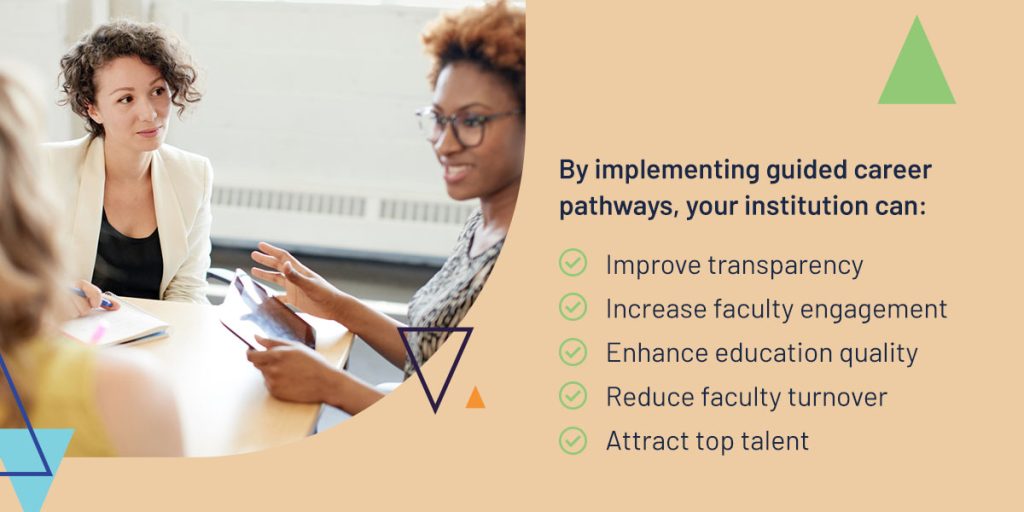




Guided career pathways help faculty visualize their career journeys and give them the resources they need to succeed. This support is invaluable as they navigate the various challenges in higher education today. Implementing guided career pathways can also help institutions support student success and keep faculty happy long-term.
This article explores the concept of guided career pathways and their importance in higher education. It also provides tips on creating career pathways that support both faculty and institutional growth.
A career pathway is a structured framework that acts as a roadmap for employee career progression. It lists the various positions an employee can reach within the organization and the skills and experience required to advance. While career pathways can provide beneficial clarity to faculty, higher education institutions can go one step further by creating guided career pathways.
Guided career pathways are similar to typical career pathways, but they offer extra details, support, and guidance for each individual’s career. Administrators can personalize these pathways to prioritize each faculty member’s professional goals. The pathway should also include development opportunities and support systems to aid faculty on their growth journey. With these resources, faculty feel more supported and able to achieve their career aspirations.
Guided career pathways can help faculty visualize their careers and motivate them to pursue development initiatives. Without clear career guidance, faculty may deal with:
When faculty have access to guided career pathways, they’re usually happier and do better in their roles. Beyond their impact on faculty, guided career pathways also benefit higher education intuitions. By implementing guided career pathways, your institution can:

Consider the points below to develop guided career pathways that support both faculty and institutional success.
Career pathways affect faculty and their careers, so they should reflect their goals and challenges. When developing pathways for your institution, work with each staff member to create a path that best supports their interests. Doing so can make faculty more interested in their career progression and, ultimately, happier working for your institution.
While supporting faculty is the primary goal of guided career pathways, they should also benefit your institution. Work with other decision-makers in your organization to outline key goals and metrics. Use these to guide faculty pathway development and ensure that included roles and training help your institution achieve its goals.
Data is essential to the success of your institution’s career pathways. You’ll need data to track faculty progress toward outlined goals and understand the extent of their contributions. This will aid in performance reviews and promotion decisions. Use dedicated software to collect faculty data and streamline the process so it doesn’t take up too much of their time.
Collecting feedback from faculty will help you understand how they are coping with new career pathways. Connect with faculty regularly to gather their feedback and address any issues. Use annual reviews to analyze their performance and advance their careers. If faculty members request extra support or adjustments to their pathway, you can make changes earlier to ensure they remain satisfied.
Guided career pathways require substantial resources to create and maintain. To ensure pathways are worth the investment for your institution, you can evaluate their impact on key performance metrics like faculty retention and student performance. Tracking changes to these metrics can help you understand how well guided pathways work for your organization.
Guided pathways can transform your institution and steer faculty toward success. We’ve recently added a new module to Watermark Faculty Success, called Faculty Career Pathways, to help you do just that. This new module provides a central location for faculty and administrators to track career paths and monitor progress toward professional milestones.
At Watermark, we create award-winning higher education software to help you make data-backed decisions driven by student and faculty insights. Request a live demo today to see how it can support your faculty and institution.































































































































































































































































































































































































Submit this form to schedule a meeting with one of our reps to learn more about our solutions. If you need customer support instead, click here.